

How can a small studio survive in an industry dominated by huge firms? That's what we're trying to find out with our new, weekly series, Small Studio Snapshots.
This week, we're talking with West of West, a practice based out of Portland and Los Angeles.
How many people are in your practice?
Clayton: Currently there are three people in the office. We have a couple satellite employees/friends that help us work with certain projects.
Jai: We bring in the ringers when we need to. The ambition is to grow the office in a long-term, sustainable way.
Clayton: We all share a design and production role as much as possible. Between the partners, we are constantly tossing projects back and forth. We’ve always worked that way. Our best projects typically have the most hands on them to work out all the kinks. By passing a project through multiple designers we really think we get the best, most resilient projects that communicate the intent to the broadest audience possible.
Jai: This idea of single-ownership, of one hand coming up with every idea in an office, is very old school. Sometimes it works out, but as the profession shifts and tries to define its future I think all of our peers are looking to find other ways to develop an office, a brand, and a body of work. Years ago we actually started as a place for all of our friends to bring their work under—sort of a conceptual umbrella, a collective brand—but it was too early in our careers for anyone to know what they were doing.

Why were you originally motivated to start your own practice?
Jai: For me it’s always been the goal, to the point where I couldn’t imagine doing anything else. My dad was always an entrepreneur and small business owner and encouraged me to find my own path. When Clay and I first started collaborating it was over a few beers after studio, very informal. But that was the spark: coming up with our own ideas and having full ownership over them, guiding them, and ultimately transforming them into real, built projects. It started as a passion project and ten plus years later—18 months full-time—here we are.It almost doesn’t matter what scale the project is because you learn so much just going through that process.
Clayton: Jai and I have had a long history of collaborating on student and professional work. We both went to Cal Poly, San Luis Obispo for undergrad, UCLA for grad school, and then we both worked at Morphosis together. During those years, we were always working on some type for project on the side, either a competition or some sort of speculative project. Always with the hope to generate enough material to start our own practice.
Jai: And the hope of doing work that gets built. We always joke “Real Work for Real People,” but it’s true. We are passionate about doing work that is culturally and socially relevant and that is actualized, that is built. We’ve been fortunate that most our work is 'Real Work'. It almost doesn’t matter what scale the project is because you learn so much just going through that process.

What hurdles have you come across?
Clayton: The biggest hurdle for me was taking the leap and leaving my day job. It was really one of those moments when you just have to go for it. We had built the business up with a pool of clients, active projects, and work on the horizon at that point. Even Jai had left his job already, I was literally the last piece of the puzzle. It was like either we do this and fail and move on, or we do this and it will work out, but either way we are doing this right now.
Jai: Convincing Clay that he should quit his day job! That one took about a year. Other than that, the biggest challenges are the seemingly boring hurdles required to run a legitimate business. Taxes, accounting, invoices, contracts, payroll, forecasting, marketing, PR, and on and on. They don’t teach that in school, and every firm I’ve worked for has done it differently.
There is no guide book for running an architecture office
Clayton: There is no guide book for running an architecture office. Every practice is really its own unique mix of design philosophy, agenda, and client relationships that’s very hard to replicate. Yes, there are some rules of thumb to keep things afloat, but really at the end of the day the risks and decisions are completely our own which is a little terrifying and super exciting. So finding the right mix for us is a challenge, but also a very fun process to go thorough.
Jai: So far we’ve been very lucky to have great clients but that is a hurdle we’re always trying to be aware of. A client that isn’t on the same wavelength can make a project challenging. The biggest hurdle so far has been trying to find time to work on internal projects that are a critical tool to both expand the conceptual framework of the studio and prove that we can do larger work.

Is scaling up a goal or would you like to maintain the size of your practice?
Jai: For where we are today we are the perfect size, and we’re looking to get more growth this year as our projects get larger. Ultimately do we want to be 200 people? No way. Probably not even 50. I always try to think about creating a studio environment where I would like to work as an employee and what that would look like.
Clayton: Right now, we are more focused on building a sustainable culture around the work we have and make sure we are serving our clients in the best way possible. We also wouldn’t refuse chasing a larger project. We are comfortable in that setting as we have both worked for larger firms previously. I think partnering your way to larger project is probably the better way to scale growth in the immediate future. That would be us, working in collaboration with another office that share the same values.I like being in control of my future and I enjoy the risk that is the price of that control
What are the benefits of having your own practice? And staying small?
Clayton: As a small office we can really focus on all quality of all the things we make. Both things we send out into the world, and the culture that surrounds our work. Both Jai and I have a hand in pretty much every project from a design and production side of things. I enjoying being able to collaboratively talk about the work every step of the way and involving our clients into the discussion whenever possible. With a small office, you can be involved everywhere which is great. Also, for our employees, we can involve them in all aspects of a project which is the best way to really have others engaged in the work.
Jai: I like being in control of my future and I enjoy the risk that is the price of that control. Will we get the project? Will it be great? Will they pay us? Everything is bearing on us to make it happen and I get a lot of satisfaction from that daily challenge.

Do you run a practice with six or less people? Get in touch!
Writer and fake architect, among other feints. Principal at Adjustments Agency. Co-founder of Encyclopedia Inc. Get in touch: nicholas@archinect.com
4 Comments
Best of West ;)
So hard to tell if any of these projects are actually built or if this is just a speculative practice trading in renderings. These guys look like they have good ideas - I hope they are finding ways to bring them into construction.
@Janosh especially given this line "Real Work for Real People" Per their website though, they have a few built projects. Retail/storefronts mostly but a nice addition in Venice.
Went to Cal Poly with these two- super talented and hard-working guys. Cool to see them featured on Archinect with some beautiful work! Loving these small studio snapshots.
Block this user
Are you sure you want to block this user and hide all related comments throughout the site?
Archinect
This is your first comment on Archinect. Your comment will be visible once approved.